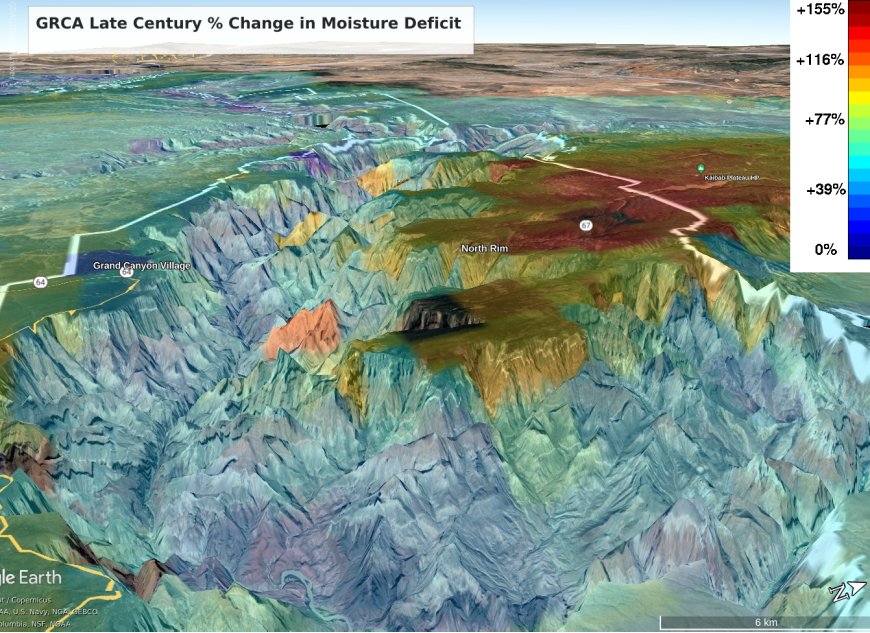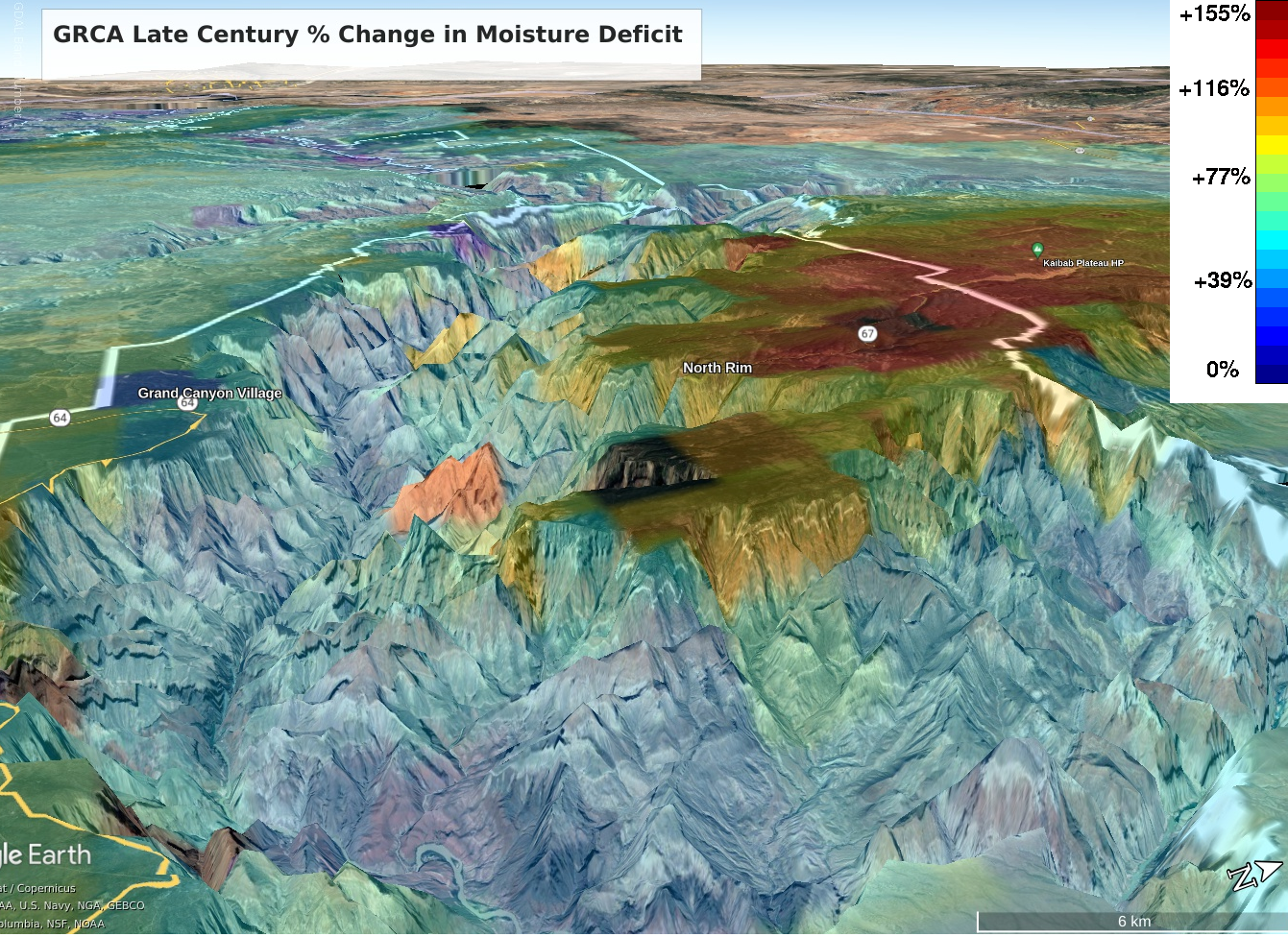Project Profile: Deliver Vulnerability Assessment Data and Tools Online to Accelerate Climate Adaptation in Parks (U.S. National Park Service)

A Single Climate Future for Grand Canyon National Park

NPS / Melanie Wood
This report aims to enhance the National Park Service’s (NPS) capacity to assess climate change vulnerability and formulate adaptation strategies for national parks. It involves the development of a web interface providing park-specific climate data, including figures and summaries of climate metrics that inform and support decisions on managing park resources. The project synthesizes climate change vulnerability assessment (CCVA) data, making it accessible to parks, programs, and partners. Two core elements involve online delivery of park-specific climate projection summaries and the establishment of a standardized method for selecting regionally appropriate climate futures.
Why?
Climate change has significantly impacted national parks. The project addresses methodological challenges in selecting plausible climate futures for scenario-based adaptation planning, a crucial component in decision-making processes. It recognizes the importance of empowering parks, programs, and partners with park-specific data and tools to address high-value, site-specific climate-related challenges.
What Else?
This project unifies years of work in the NPS to provide park-specific information products summarizing projected climate changes. It makes existing resources widely available to empower independent efforts by parks and programs. The initiative aligns with the DOI Climate Change Action Plan, the National Fish, Wildlife, and Plants Climate Adaptation Strategy, and the NPS Climate Change Response Strategy. Finally, the employment of youth supports both project elements, contributing to workforce development.
SDGs, Targets, and Indicators
-
SDG 13: Climate Action
- Target 13.1: Strengthen resilience and adaptive capacity to climate-related hazards and natural disasters
- Target 13.2: Integrate climate change measures into national policies, strategies, and planning
- Target 13.3: Improve education, awareness-raising, and human and institutional capacity on climate change mitigation, adaptation, impact reduction, and early warning
- Target 13.a: Implement the commitment undertaken by developed-country parties to the United Nations Framework Convention on Climate Change to a goal of mobilizing jointly $100 billion annually by 2020 from all sources to address the needs of developing countries in the context of meaningful mitigation actions and transparency on implementation and fully operationalize the Green Climate Fund through its capitalization as soon as possible
-
SDG 15: Life on Land
- Target 15.1: By 2020, ensure the conservation, restoration, and sustainable use of terrestrial and inland freshwater ecosystems and their services, in particular forests, wetlands, mountains, and drylands, in line with obligations under international agreements
- Target 15.2: By 2020, promote the implementation of sustainable management of all types of forests, halt deforestation, restore degraded forests, and substantially increase afforestation and reforestation globally
- Target 15.5: Take urgent and significant action to reduce the degradation of natural habitats, halt the loss of biodiversity, and, by 2020, protect and prevent the extinction of threatened species
Analysis
The article discusses a project aimed at enhancing the National Park Service’s capacity to assess climate change vulnerability and formulate adaptation strategies for national parks. The project involves the development of a web interface providing park-specific climate data and summaries of climate metrics to support decision-making on managing park resources. It addresses methodological challenges in selecting plausible climate futures for scenario-based adaptation planning.
1. Which SDGs are addressed or connected to the issues highlighted in the article?
The issues highlighted in the article are connected to SDG 13: Climate Action and SDG 15: Life on Land. The project aims to assess climate change vulnerability and develop adaptation strategies, which align with SDG 13. Additionally, the project focuses on managing park resources and addressing climate-related challenges, which are relevant to SDG 15.
2. What specific targets under those SDGs can be identified based on the article’s content?
- Under SDG 13:
- Target 13.1: Strengthen resilience and adaptive capacity to climate-related hazards and natural disasters
- Target 13.2: Integrate climate change measures into national policies, strategies, and planning
- Target 13.3: Improve education, awareness-raising, and human and institutional capacity on climate change mitigation, adaptation, impact reduction, and early warning
- Under SDG 15:
- Target 15.1: Ensure the conservation, restoration, and sustainable use of terrestrial and inland freshwater ecosystems and their services
- Target 15.2: Promote the implementation of sustainable management of all types of forests
3. Are there any indicators mentioned or implied in the article that can be used to measure progress towards the identified targets?
The article does not explicitly mention specific indicators. However, indicators that can be used to measure progress towards the identified targets may include:
- Number of national parks with climate change vulnerability assessments
- Extent of integration of climate change measures into national park policies and planning
- Level of education and awareness on climate change among park staff and partners
- Extent of conservation, restoration, and sustainable use of terrestrial and inland freshwater ecosystems in national parks
- Extent of implementation of sustainable forest management practices in national parks
SDGs, Targets, and Indicators
| SDGs | Targets | Indicators |
|---|---|---|
| SDG 13: Climate Action |
|
|
| SDG 15: Life on Land |
|
|
Source: nps.gov








